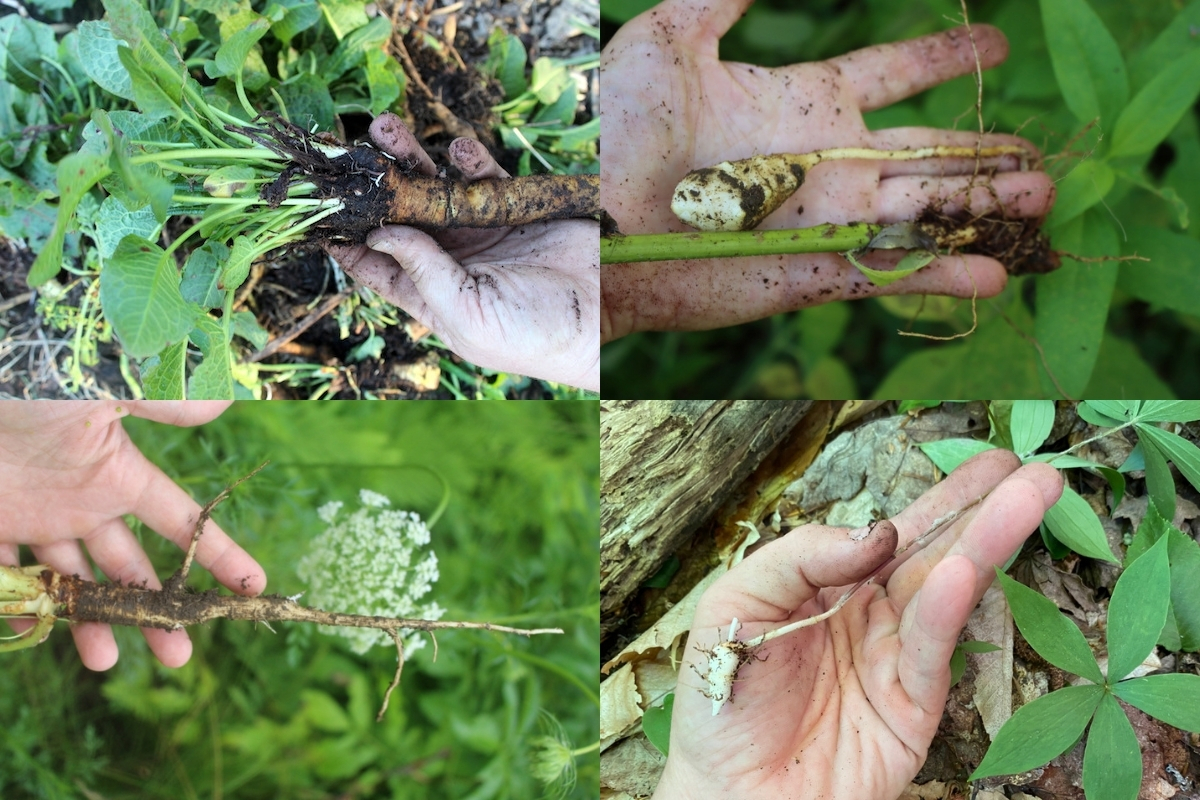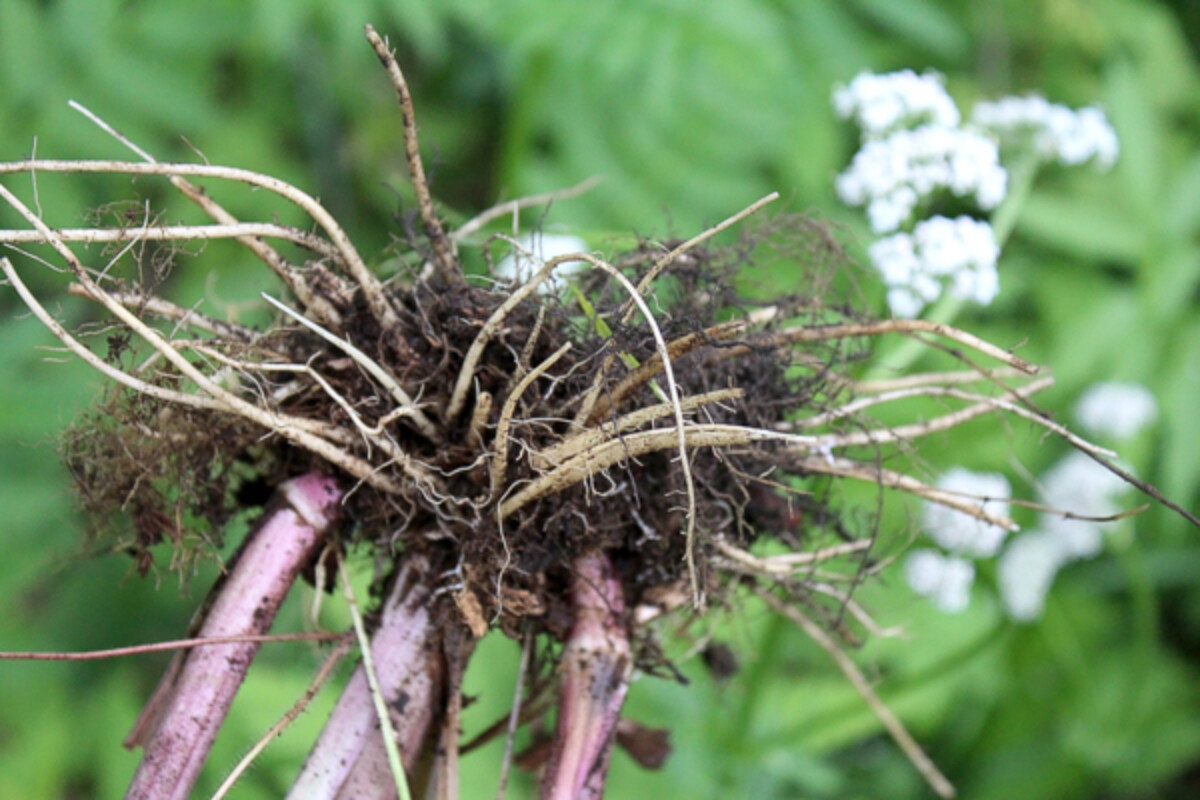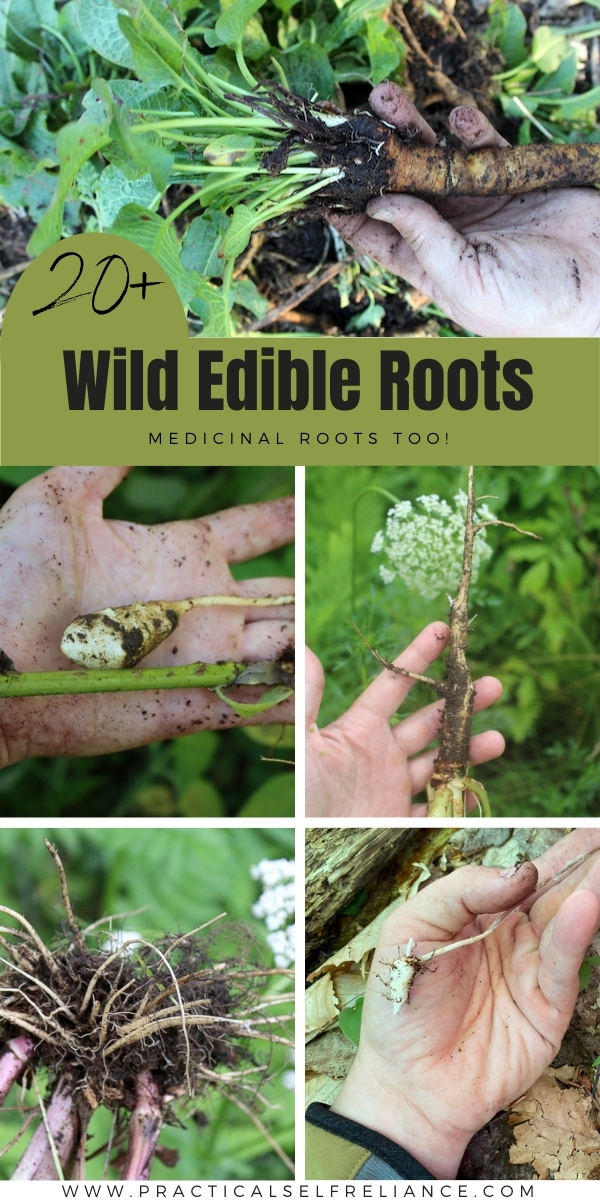Affiliate disclosure: This post may contain affiliate links. Please see our Privacy Policy.
Wild edible roots and tubers can form the basis for a wild foods diet, providing more calories and nutrition than a few wild foraged weeds.

A while back I was having lunch with my little ones in a park, and a young couple, seemingly on a first date was not too far off. They were having an animated conversation about, of all things…foraging!
I couldn’t help but listen, giggling to myself that the world of dating has come a long way since I was younger, and now these two are trying to woo each other with their foraging prowess.
One of them would brag about their haul of wild leeks (aka. ramps) earlier in the season, and the other was quick to drop every fact they knew about those tasty wild bulbs.
I don’t often meet other foragers out and about in the world and it was tricky for me to bite my tongue as they talked about my passion just a few yards away. Not my place, not my date…but I do hope it works out for that pair!
Right before they headed out, they both vehemently agreed that you never, under any circumstances forage wild roots! Never! That’s just so incredibly dangerous!
Anything below ground has to be off-limits….which I’ll admit is kind of ironic, given the previous brag about wild leeks, though they’re probably only harvesting the leaves.
Irony aside, I was kind of surprised. I dig plenty of wild roots, though I’m no expert on the subject. Of course, there are toxic species, that’s true of leaves, fruit, and anything else.
For some reason, people are intimidated by foraging roots and tubers, partially because it involves a bit more work than plucking edible wild berries off a bush. But also I think a lot of the reluctance stems from fear.
It’s true, there are some incredibly toxic roots out there. But there are also some incredibly poisonous berries, and that doesn’t stop just about everyone from picking blackberries along the hiking trail.
Why? Well, a blackberry looks like a blackberry of course! There’s really nothing that looks like a blackberry, except other edible rubus species, which are also tasty and delicious.
That’s true of many roots as well, and if you learn them, they’ll be no less intimidating than trailside berries.
Wild Edible Roots and Tubers
That experience got me thinking, and I really want to write more about the dense calorie sources that are available in the form of wild roots and tubers. There’s a handful that I forage regularly, but still, there are more that I know but rarely bother with.
I consider myself an adventurous forager, but ya know, sometimes I get lazy like anybody. I know cattail roots make excellent flour, but sometimes lounging by the pond is nicer than wading into the muck to harvest pancake ingredients.
Still, I need a new challenge, and this is enough to spur me into it. A few years back, I decided to try to find every edible berry and fruit in my local landscape, and I came up with more than 50 different species.
Next, I’m going underground to try to find as many edible wild roots as possible.
This obviously isn’t an exhaustive list, and I’m sure there are plenty of tasty roots that I haven’t tried (yet). I’ll work to add to it over time, and please do leave me a note in the comments if you see any that definitely should make the list.
I’ll add links as I write about each one, but for now, I’m posting this as a starting point mainly because I’d like feedback.
What’s your experience foraging wild roots and tubers? What are your favorites? What’s missing from my list?
(Leave me a note below in the comments.)
I did some quick research, and here’s what I found for edible roots. Most I knew, but some I had never heard of, and I have no verification of their edibility beyond spotty online sources, so please verify with other sources and don’t just take my word for this (or anything really, you should always double-check).
- Arrowhead (Sagittaria latifolia)
- Bistort (Polygonum bistortoides)
- Bull Thistle (Cirsium vulgare)
- Burdock (Arctium sp.)
- Cattails (Typha sp.)
- Chickory (Cichorium intybus)
- Chufa (Cyperus esculentus)
- Cucumber Root (Medeola virginiana)
- Dandelion (Taraxacum officinale)
- Daylily (Hemerocallis sp.)
- Evening Primrose (Oenothera sp.)
- Garlic Mustard (Alliaria petiolata)
- Ground Nut (Apios americana)
- Lesser Celandine (Ficaria verna)
- Lotus, American (Nelumbo lutea)
- Pignut (Conopodium majus)
- Ramps or Wild Leeks (Allium tricoccum)
- Sego Lily (Calochortus nuttallii)
- Shepherd’s Purse (Capsella bursa-pastoris)
- Spring Beauty (Claytonia lanceolata)
- Solomon’s Seal (Polygonatum sp.)
- Sunchokes or Jerusalem Artichokes (Helianthus tuberosus)
- Trout Lily (Erythronium pudica)
- Wild Carrot or Queen Anne’s Lace (Daucus carota)
- Wild Parsnip (Pastinaca sativa)
- Wild Potato (Orogenia linearifolia)
Be aware that many of these require processing to consume, and are not edible raw straight from the ground. Beyond that, others have toxic or dangerous parts.
The leaves of wild parsnip, for example, can cause a rash from contact with skin. Wild carrot has a deadly toxic look alike too.
Be careful, and do your research before attempting to forage any of these wild roots. Always consult multiple sources, and always be 100% sure of your ID before eating any wild plant.
This is, as I said, just a jumping-off point for further research…and a bucket list of sorts for myself.
Medicinal Roots
Beyond the edible roots, there are a few wild roots and tubers that are “edible” but generally consumed in small quantities for medicinal benefit. You can harvest them and they’re definitely useful, but you’re not exactly going to cook a meal from them.
I’m just adding these here for completeness, given that they are eaten medicinally, even if in small quantities. Know that while they may be edible in small doses, that doesn’t mean they’re not problematic or even toxic in large doses.
- Barberry (Berberis vulgaris) – An upright invasive bush in the US, and I commonly eat the berries. Haven’t yet harvested roots.
- Comfrey (Symphytum officinale) – Most sources suggest sticking to external uses only (like comfrey salve), since even small doses may be toxic, though it has a history of internal use historically.
- Dock (Rumex Sp.) – Reportedly edible, but I have a reaction to it, and it tastes horrible. Plenty of people use it for both food and medicine though.
- Echinacea (Echinacea purpurea) – We regularly make echinacea tincture and echinacea tea.
- Elecampane (Inula helenium) – We use this for homemade cough syrup, and I personally find it extremely effective.
- Marshmallow (Althaea officinalis) – Marshmallow root tea is incredibly soothing for sore throats and cough, and I keep it on the shelf for winter remedies.
- Mullein (Verbascum thapsus) – I use the leaves and flowers, and only recently learned the root is used medicinally as well.
- Japanese Knotweed (Reynoutria japonica) – Traditionally used for Lyme disease.
- Valerian (Valeriana Officinalis) – Used as a sleep aid, often as a herbal tincture.
- Wild Ginger (Asarum canadense) – Small doses, and use caution as it may be toxic.

Poisonous Roots
Though obviously you’re not just going to dig up any root and eat it out there in the wild, there are a few to really avoid while foraging roots.
This is definitely not an exhaustive list, but just a few of the most common poisonous roots, especially those that have edible look-alikes.
As always, make sure you’re 100% positive on your identification before eating any wild plant, and always consult more than one source when trying to identify a plant.
- Belladonna (Atropa belladonna) ~ Most poisonings are from the berries, which are really beautiful and especially attractive to kids. The whole plant is deadly toxic though.
- Bloodroot (Sanguinaria canadensis) ~ Sometimes used medicinally in external preparations, I don’t think it’s worth the risk. It can cause extreme contact burns and I avoid it altogether. Still a beautiful spring ephemeral to appreciate in the forest, just enjoy with your eyes.
- Elderberry Root (Sambucus sp.) ~ Though the berries are edible and medicinal when cooked, all other parts of the plant at considered toxic.
- False Hellebore (Veratrum viride) ~ Occasionally confused for ramps by novice foragers since they appear at the same time in the early spring. Other than being low-growing green leaves, they don’t really look anything like ramps in my opinion. Still, avoid them as a toxic plant.
- Greater Celandine (Chelidonium majus)
- Jack in the Pulpit (Arisaema triphyllum)
- Mandrake (Mandragora sp.)
- Pokeweed (Phytolacca americana) ~ Leaves are sometimes consumed with the right preparation, even though some sources list the whole plant as toxic. Avoid the roots and berries though.
- Water Hemlock (Cicuta sp.) ~ A close look-alike with Queen Anne’s lace, but deadly toxic. I avoid Queen Anne’s Lace roots for this reason.
Foraging Guides
Looking for more foraging guides? Read on…
- 60+ Dandelion Recipes
- 50+ Ways to Use Yarrow
- 12+ Chokecherry Recipes
- 100+ Medicinal Plants and Their Uses















I was looking for this one. Pediomelum esculentum, was Psoralea, is one in the prairies. Also Amphicarpea bracteata with underground ‘nuts’ similar to peanut, Camassia, Callirhoe, some Liatris, and Ipomoea leptophylla, bush morning glory. There are lots more that were eaten by tribes.
We harvest Indian breadroot/Indian turnip on our property in western SD. I even harvested seeds this fall and will attempt to cultivate it in my garden next year!!
Here are a few more for your list!
American Sarsaparilla ( Aralia nudicaulis)
Rhizome is edible but used more medicinally. It is related to ginseng and has somewhat similar properties.
Wood avens (Geum urbanum)
These roots have a lovely clove taste!
Water avens ( Geum rivale)
These are medicinal to me as well. Quite astringent but are especially good at healing mouth sores.
American bugelweed (Lycopus americanus)
Delicious crunchy tubers!
Mugwort (Artemisia vulgaris)
These roots are an interesting flavor profile. Listed as “chocolat substitute” but they dont taste like chocolate. Anyway they go along with the sweet side of things.
Bugelweed tubers I have not found in the north where I now live. (Québec) The tuber species is more southern I guess. We had them in Alabama.
Awesome, thank you so much!
In Klamath County we have a plant pronounced Apaw, we find in scab rock flat, It has an umbrella white flower from a 8-10 inch stem and has small peanut shaped roots with a dark brown shin and white meat, it Tast similar to a cross between a potato and a carrot. What is the plant called? We dig them with shovel or 6-10 inch screw driver, very tasty root. Maybe 2-5 tubers under each plant
I’m not sure what that would be. If you have pictures, there is a great plant identification group on Facebook that might be able to help.
I read your article while trying to find out if Turkish rocket roots were edible. (Still haven’t found out) just wanted to share that in the UK it is illegal to dig up wild plants without the landowners permission.
In the US, it’s just the opposite. It’s common courtesy not to mess with anything in someone’s yard, but in the vast tracts of open land, you can harvest for your own use (not commercial, not reselling) unless it’s explicitly posted that you can’t. The posting laws are pretty strict, and the sign need to be no more than 30 feet apart around the whole perimeter of the property, and then on top of that you have to register it with the town that it is posted or it doesn’t count. On this side of the pond, access to wild land is very protected…but still, it’s obviously common courtesy not to just randomly dig up things in land that doesn’t belong to you without permission.
I was moving a raspberry patch gone wild and came across a tuber that looked like a wild carrot. It was fall after a few frosts but before the ground had frozen, so all the foliage had died off and was removed. This tuber didn’t smell like carrot, or Queen Anne’s lace, so I though maybe Burdock? I thought I’d just taste it to see what I thought. No taste at first, so I swallowed maybe a teaspoon full of the juices in my mouth and spit out the pulp. It took a couple of moments to find a bitter, unpleasant taste. An hour later, I repeatedly vomited profusely, became shaky, even had flash blackouts.
With a bit of research, my best conclusion is the tuber was Pokeberry. You don’t want to eat that tuber!
Thanks! Excellent article,
I love information.
Wow! I learned so much from your blog.
Pat Argentinian
we grow and harvest burdock and arrowroot. Wild burdock can be so stringy it’s inedible but there is a cultivated variety bred in Japan that is fast growing and delicious, with roots up to a metre long. Arrowroot is usually stringy- chop, soak then dry the flour extracted for a clear thickener. can provide more detail if you wish. I also write on wild foods and self sufficiency, but am in Australia.
Love your posts. I just planted garlic having found some hard neck at an orchard. I am an amateur forager and have been for 60 or so years. I live in western MA, so our environs are similar.
Thanks
Jan
I have lots of experience with Jerusalem Artichoke (Sunchokes). i have used my grandmother’s recipe for decades when making Jerusalem Artichoke relish. It is absolutely delicious! I also slice them with minced garlic and sautee in butter and olive oil. That, too, is delish!
Also, my husband and I look forward to Spring each year and foraging Poke Salad.I never use any leaves near a road as I have no desire to consume vehicle exhaust fumes! I boil the leaves for about 20-30 minutes depending upon the size of the leaves. If I have large ones, I go f the full 30 minutes. Then I pour the contents into. collender o drain. Meanwhile, I sautee lots and lots of onions until they are brown…not burned but brown. I add the cooked leaves to the skillet (iron, of course) and let the flavors combined for a moment. We try to eat them as often as we are able to find Poke Salad.